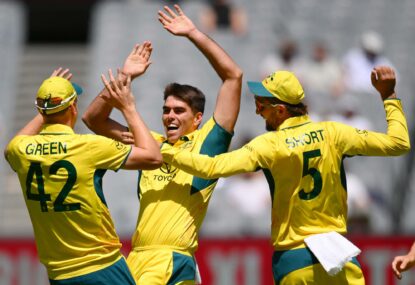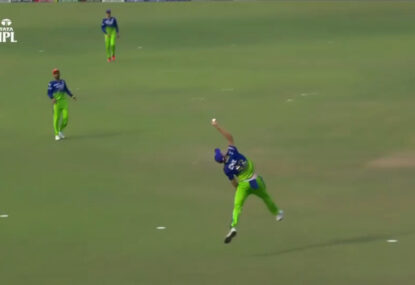Ever since Shaun Marsh made his Test debut for Australia in 2011 he has tossed up more questions than a tabloid crossword.
To put his patchy career for the baggy green into perspective, selection for the first Test against Pakistan at the Gabba in just over a fortnight’s time would make it his eighth recall.
Time and again, both form and injuries have hindered his Test prospects.
A timely ton for Western Australia in the Sheffield Shield has repeatedly seen the left-hander’s name thrown back into the ring for possible Test selection.
As his recent recovery from a broken finger in the Perth Test has shown, return from injury – most commonly from rickety hamstrings – has also continually been met with whispers at the selectors’ round table.
One of the strongest reasons why Marsh shouldn’t gain selection for the Gabba Test is that the selectors opted to blood young talent in Adelaide and should thus allow those young guns ample time to prove their worth.
If the West Australian was to slot back into the Australian line-up he would either replace Matthew Renshaw at the top of the order or Nic Maddinson lower down.
Renshaw only made 10 and 34 not out in his debut Test at Adelaide, however a dig below the surface reveals a batsman with enormous talent.
After a mercurial Faf du Plessis declaration late on day one, Renshaw survived the final 12 overs of the day under lights against a swinging pink ball on a pitch with a tinge of green.
Not only did he leave Australia 0-14 at stumps against arguably the most potent bowling attack in world cricket, but he did so without fellow opener David Warner at the other end.
The 20-year-old’s second dig was infinitely more impressive.
With Australia needing 127 to win its first Test match after five worrying losses, Renshaw orchestrated the run-chase with a sturdy innings of 34 from 137 balls.
After losing 10 wickets for 86 runs in the first innings at Perth, getting skittled for 85 in the first innings at Hobart and losing eight wickets for 32 runs in the second dig, Australia was in desperate need of a batsman that could score ugly runs.
Mark Taylor, Justin Langer and Chris Rogers all assumed the role admirably in years gone by, and Australia was yearning for one more barnacle capable of resisting the rough seas.
Renshaw let countless balls carry through to Quinton de Kock behind the stumps in the second innings at Adelaide. In fact, of the 137 balls he faced, 122 were dots. Time wasn’t an issue because the hosts had just over four sessions to chase a meagre total.
Renshaw showed maturity beyond his years in waiting so patiently to smack the loose balls for four.
Perhaps the most remarkable statistic regarding the Queenslander’s innings is that he became just the second-youngest player to open the batting on debut in a post-WW11 Test match for Australia. Only the late Phillip Hughes was younger.
One last important consideration regarding the Gabba Test is that Renshaw should be well-equipped to face the expert swing of Pakistani pace duo Mohammad Amir and Wahab Riaz.
A top-order batsman in the mould of Renshaw, given his willingness to leave a lot of balls and not play too hard at the red leather, will be vital to Australia’s success in the opening Test.
The most likely batsman Marsh would replace for the Gabba Test is Maddinson.
Having said that, Maddinson’s case is similar to Renshaw’s in that the New South Welshman was also given an opportunity at Test level as a promising young talent.
Should he be given more than one Test to prove his merit?
Maddinson only batted in the first innings at Adelaide and although he made a duck, he did receive a devastating Kagiso Rabada delivery – a 145kph-plus in-swinging yorker.
Maddinson wasn’t a safe selection for the third Test, although he wasn’t a bad selection either.
The selectors picked him on potential, as was the case with a number of daring experiments in the past that proved to be of immense success.
Steve Waugh, Michael Slater, Justin Langer and a number of other batsmen were all thrown into the Test arena not having played 20 first-class matches and at a younger age than Maddinson.
Of course, however, the man vying to slip back into the Australian top-six in Brisbane so too present a strong case.
Since returning to the side alongside Warner at the top of the order, Marsh has been in magnificent touch.
He was recalled for the third Test in Sri Lanka in August in which he top-scored for Australia in an innings of 130.
What followed was a commendable 63 in Perth, an innings preceded by a Sheffield Shield century against a South Australian attack boasting quality pacemen in Chadd Sayers, Joe Mennie and Kane Richardson.
Perhaps the most significant thing about Marsh’s Colombo ton is that Australia will return to the spinning decks of the subcontinent against India in a four-Test series next February and March.
Australia has historically found little success on the dusty subcontinental decks.
The baggy green hasn’t won a Test series on the subcontinent since beating Sri Lanka at home 1-0 in 2011.
Australia also hasn’t won a Test series in India since 2004 in a 2-1 win.
What’s more is that the 3-0 loss to Sri Lanka in August was against a side missing recently retired batting giants Kumar Sangakarra and Mahela Jayawardena.
Playing Marsh in the series against Pakistan in light of the series against India to come could prove a wise move.
So there we have it: the case for and against Marsh’s return to the Australian Test side.
I share the view of Ian Chappell, who recently said he “put a line through Shaun Marsh’s name a while ago”.
After suffering its first Test loss of an Australian summer since 1988 and compounding this with an innings defeat in Hobart, the solution was to reignite the side with youth booming with talent.
After success in Adelaide, the selectors should continue to back its youth and build a batting order centralised around senior players in Warner, Steve Smith and the maturing Usman Khawaja.
Despite red-hot form of late, Marsh shouldn’t play another Test for Australia.
Renshaw and Maddinson must remain for the Gabba Test and players like Cameron Bancroft, Kurtis Patterson and Travis Head should be dominating headlines regarding players hot on their heels for Test selection.
The future of Australian cricket is before our eyes.





































































































